
Handling cattle
The correct handling of cattle is a vital component of quality food production and good animal welfare. Handling cannot improve the basic product, but good handling will minimise product quality loss and lessen stress on animals.
The basic elements of animal handling are the handler, the stock and the facilities. These elements are all interdependent.
An understanding of these dependencies is essential for continued improvement in cattle handling. Research and practical observations have identified factors pertinent to each element.
These are:
Handler — Desirable attributes for handlers are a positive attitude to stock; understanding of animal behaviour; the ability to recognise and interpret animal actions; and the allowing of sufficient time for operations.
Livestock — Livestock differ in their ease of handling due to factors including previous experiences, breed characteristics, sex and physiological state.
Facilities — Poorly designed or maintained facilities can lead to confusion and stress on cattle. There is a higher incidence of stress and injury to both stock and handlers in a poorly constructed facility. The basic element of design is to allow for good stock flow. The larger the facility and the more diverse the livestock history, the more important it is to correctly design the facility. This is equally true for saleyards, feedlots and abattoirs.
Handling cattle
To handle cattle correctly, an understanding of animal behaviour is essential. In fact, the greater the handler's knowledge of cattle behaviour, the better their ability to predict an animal's response. And the better the ability to predict animal responses, the quicker and easier the job and the lower the probability of injury to animals or people.
Cattle, because of their size, strength, speed and potential for aggression, need to be handled thoughtfully and with confidence.
The most important aspect of handling any livestock is to be able to recognise and interpret an animal's reactions. The beast's 'body language' will indicate its probable actions.
Behavioural characteristics of cattle
- Cattle remain immobile when first threatened. Their first reaction is to stand and assess the situation. If frightened, their natural instinct is to escape.
- Cattle try to maintain other animals within their vision. They have a field of view of 330° and have the ability to see threats from almost all directions.
- Social order in the mob is usually established at about 2 years of age and maintained by threats and butting. When mobs are mixed, social order has to be re-established so aggression occurs until a new order is established. This may hinder movement of stock.
- Within a mob of cattle, there is an order of dominance. This can be seen in action at the water or feed trough where certain animals are always first to drink or eat. Other animals tend to stand back until the dominant animals have finished. Dominance may also be seen when cattle are on the move. The same animals will usually lead the mob. They will also be the first to enter gateways. Dominance and the need to maintain hierarchy in a group of cattle becomes a problem when the animals are in confined spaces such as holding yards. This can be a cause of significant stress within a mob. Crowding of cattle will also increase aggression as the animals try to maintain personal space.
- Social behaviour varies with age, breed, sex; Bos indicus and Bos indicus-cross animals are more sensitive/temperamental than British or European breeds.
- Young bulls, when moved in groups, show a degree of playfulness (pushing and shoving), but bulls become more aggressive and territorial with age. Adult bulls have large personal space (6 metres or more). When adult bulls are crowded, fighting will occur at gateways or in yards.
- Bulls are uncontrollable when fighting. They become highly aroused and will break away suddenly. Handlers have to be extremely careful to avoid injury.
- Cows with young calves can be very protective, so handling them in the presence of their mothers can be dangerous.
- Cattle, particularly Bos indicus breeds, do not like being singled out either in the paddock or in yards. They can become extremely agitated and aroused.
Principles of cattle handling
Arousal
Arousal is the state of activity of animals and ranges from deep sleep to fight/flight.
Handling techniques raise the level of arousal. However, if you control the level of arousal, you control the animal.
Problems occur though when this arousal is too high. Highly aroused ('stirred up') animals are more likely to make sudden violent movements, and they behave in a self-protective way either by running away or fighting back.
Highly aroused animals are also more responsive to further stimulation (a bull which is highly aroused needs little provocation to attack).
It is desirable to keep animals as calm as possible so that they can move quietly. When necessary, however, handlers may temporarily raise arousal for particular purposes, such as forcing lead animals through a gateway.
Mustered cattle should be allowed to settle down before handling in yards.
Instinctive behaviour
The usefulness of instinctive behaviour is that it is predicable and requires no training of the animals. The instinct to escape is helpful when handling cattle that are reared under extensive conditions and have little contact with people.
With infrequently handled animals that are flighty and have less chance of learning the flow system of paddocks and yards, instinctive behaviour is used so that animals 'escape' to where you want them to be.
To do this, the stockperson must learn the rules of position and movement. A person moving alongside animals at just the right moment can turn a mob exactly when needed, but someone positioned wrongly can cause havoc.
Instinctive behaviour is also an important trait to consider when designing yards.
Learning/training
Cattle have good memories. Bos indicus cattle, in particular, can be taught to be mustered and worked through yards. Every time cattle are handled, therefore, it should fit into an overall training plan.
Bos indicus cattle become accustomed to the way in which they are mustered and worked through yards. The best procedures for mustering each paddock and working stock in yards should be developed and adhered to.
The best time to educate cattle is at weaning. This experience should also be made as pleasant as possible. Unfortunately, cattle have an aversion to many management procedures and they may show a reluctance or refusal to cooperate, for instance cows tossing their head when drenched orally.
Flight distance
Flight distance is an important concept in livestock handling. It can be described as a circle of safety around an animal.
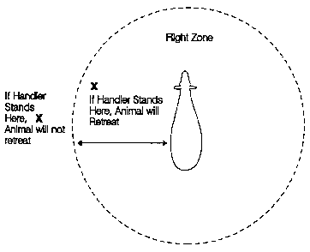
When a person penetrates the flight zone, the animal moves away. A good stockhandler knows when to penetrate this zone and when to retreat so that the cattle move quietly in the desired direction.
Cattle move most effectively if they can see the handler at all times. Attempting to drive animals by standing directly behind them is often not efficient because they turn and look at the handler. A beast is best driven when the handler is situated at a 45–60° angle from a line perpendicular to an animal's shoulder. This same principle applies to driving mobs of cattle.
The flight distance varies with the tameness of the animal. The distance may be up to 200–300 m for feral cattle, but for feedlot cattle it may be only 1–5 m. Very tame cattle are difficult to move because they no longer have a flight zone.
If a handler shouts and excites cattle, this can enlarge the animals' flight zone.
Position and movement
For a stockperson to cause cattle to move in a predictable direction, there are several 'Rules of Position and Movement'.
Point of balance
Experienced stockhandlers use the point of balance of an animal to move it. Looking from a side view, this means behind the shoulder, and from in front, it is from the centre of the head.
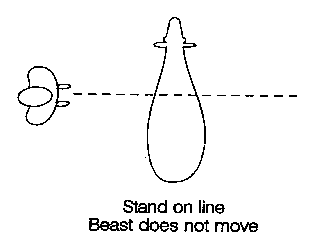 | 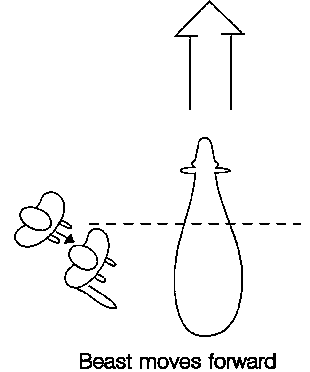 |
When close to cattle, the stockhandler's position in relation to an animal's shoulder can affect which direction the animal will head. The line through the shoulder is the point of balance. If the stockhandler goes behind this line, the beast moves forward.
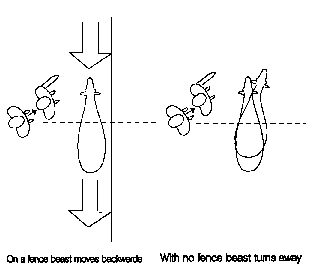
By moving towards the front of the animal, the beast will move backward or turn away.
From the front, you can deflect cattle sideways by moving either side of an imaginary line drawn through the middle of the animal's length.
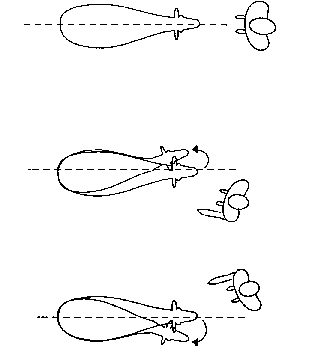
Mob movement
The principles of position and movement apply equally when moving mobs or when handling small numbers or individual animals.
A mob of cattle has a collective flight zone around the group. When the handler penetrates the zone, the mob will move.
When a mob is progressing in the right direction, the handler works on the edge of the flight zone. By alternately entering and retreating from the flight zone at the optimum position of 45–60°, the handler keeps the mob moving at the desired pace.
Mobs/gateways
Once a mob is moving through a gate, the handler should stay on the edge of the flight zone and only enter this zone if the cattle stop moving.
A common mistake by handlers is to stay within the flight zone while the majority of the mob have no escape route. This inevitably leads to cattle turning back and breaking away from the mob as they seek an escape route other than the crowded gateway.
Head movement
Cattle look in the direction they are about to go. Good stockhandlers can predict which way a beast will turn by noting the position of its head. To turn a beast, stockhandlers should therefore position themselves to turn the animal's head.
A good handler constantly watches the cattle in a mob and can anticipate any change in direction, or breakouts, by noting the head movement of the cattle at the lead and edges of the mob. The handler can therefore take appropriate action before problems occur.
Handling in yards
Cattle behaviour in yards
Cattle will normally run to a point of escape (often an entrance gate). They will also tend to circle the handler in yards and, therefore, run most consistently on the curve.
Cattle tend to follow each other, and the sight of an animal in front helps keep movement flowing. They will, however, baulk or refuse to cross strong shadow stripes. This can inhibit progress through gateways and along races.
Cattle also do not like to walk from a bright, sunlit area of the yard into a dark area such as a shed. The wrong placement of shade (shadow) can result in baulking, for instance when cattle are walking up a race.
It is often difficult to move cattle from a large area directly to a small, confined area. For this reason, cattle yards are designed so that individual yards are gradually scaled down in size toward the working area/crush.
When yarding stock from the paddock, cattle will enter the receiving yard more readily through a wide gateway if they can see space ahead of them.
Yard design
Cattle yards should be designed in a way which either uses the natural behaviour of cattle to advantage or which takes into account this natural behaviour. Unfortunately, this is often not the case and the working of cattle in poorly designed yards can add significantly to the difficulties and the duration of an operation. It also adds to the stress on both cattle and the stock handlers.
The cladding of races, forcing yards and other strategic points in yards can make cattle flow more easily. Apart from obliterating distractions on the outside of the yard, this can offer directional signals to the animals.
Working direction
Cattle should be worked through, not backwards and forwards, in yards. If cattle learn to go in one end of the yard and out the other, they will work freely without having to be forced.
Most beef producers have an established working procedure when working cattle in yards. The cattle soon learn this method and it has to be considered when carrying out procedures such as drafting.
If cattle have learnt a system and this system is then changed, far more difficulties in handling cattle can be expected. For example, entering the yard from a different direction.
Work within yard capacity
Yards should not be overcrowded, particularly for forcing yards. This is because cattle will only pack into a corner and not see the race entrance.
Drafting
When drafting cattle, there are several points to consider:
- Cattle need to see an avenue of escape, as they tend to stop and turn if they approach a dead-end.
- Do not put too many cattle in a yard as this will create insufficient room for cattle movement. (Yard should ideally be half-full.)
- There should not be too many handlers in the yard as this reduces room for cattle movement.
- Generally draft big from small animals, quiet from excitable animals (easier — excitable animals will generally keep away from handlers).
- After drafting, don't leave single animals on their own as they can get very upset, particularly Bos indicus breeds.
Handling aids
The use of drafting canes and sticks can extend the distance of control over cattle as it effectively increases the length of the stockhandler's arm.
Holding a cane in front of a beast's head will cause it to either stop or turn. Hitting an animal, though, is unnecessary and ineffective in moving animals in the right direction. Poking an animal which is already moving in the right direction is also unnecessary and dangerous as this can cause cattle to kick.
Electric prodders, however, are a useful aid if used correctly. A prodder should not be used on an animal which has nowhere to go or is already moving in the right direction, such as animals at the back of the mob.
Use of races, crushes and bails
When cattle have been separated from the mob with an individual in a race or crush, the animal is usually stressed and upset, as its flight zone can be invaded and it cannot escape. Under these conditions, there is a greater chance of injury to the beast and the handler. This is because the animal is likely to make sudden movements. These sudden movements can cause injury to handlers who may, for example, be placing an anti-backing bar behind the beast or handling the animal through the rails.
Care also has to be taken when working around a beast restrained in a head bail. These animals can still move backwards and forwards very quickly. It is also essential that bail catches and locks are effective, as injury to operators can occur and the beast may escape prematurely if the locks/catches are faulty.
The attributes of a good stockhandler
A good stockhandler should be:
- Observant — they will notice slight differences in animal behaviour or appearance, such as in one animal from the rest of the mob.
- Confident — they will always react with firm, sure movements and will always be 'the boss' while avoiding getting overexcited.
- Competent — they will have the ability to control animals and know where to stand in a yard in relation to the animals being moved and by understanding animal behaviour principles.
In addition, they will:
- always give the animals time to assess the situation before expecting a reaction;
- have a positive attitude towards the care of the animals. They will also develop a good relationship with the stock and avoid unnecessary hitting and yelling;
- make effective use of aids like canes and prodders;
- respect each animal's ability for speed and power to do injury.
They will also recognise:
- the need to draft off, or segregate, specific animals, such as bulls;
- that stock differ in their response to different situations;
- that the sexes of each species vary in their ease of handling.
They will understand:
- the difference between breeds and how they differ in the way they work as a group;
- that an animal's physiological state affects animal behaviour.
They will know that:
- dominance and the need to maintain hierarchy in a group of cattle can be a problem, especially when handling large numbers of animals in a confined area;
- isolation can be a real problem with individual animals, causing them to quickly become upset and dangerous;
- training and/or experience of the handler or the cattle can affect the ease of handling of cattle;
- horns on cattle can create difficulties when penning in forcing yards and at the entry into races. Horns are often associated with aggressiveness and can make animals less accessible for some handling procedures;
- diseased or injured animals are already stressed and may be prone to attacking handlers in an attempt to avoid being disturbed;
- weather conditions, time of day, and shadows affect animal comfort and ease of movement.
The good stockhandler will also be acutely aware of the activities which constitute a particularly high personal risk. These include:
- working in close proximity to animals — any situations like trucks and small yards increase this risk.
- handling of bulls, freshly calved cows, or isolated animals.
- working in substandard facilities — trying to make do will always increase risks.
- working with too many animals — overcrowding.
- using incorrect aids or using aids at the wrong time and place.
- poor communication between handlers — perhaps too many handlers in the yard.
References
Gahan RJ & Johnston BD Handling Cattle from Farm to Abattoir.
Bulletin, NSW Agriculture, Orange
Hurst RJ & Johnston (1986) Livestock Handling and Transport Study Tour — Victoria, NSW Agriculture, Orange
Holmes RJ (1984) Sheep and cattle Handling Skills - A Manual for New Zealand Conditions, Accident Compensation Corporation, Wellington
Temple Grandin — Livestock Psychology and Handling - Facility Design, www.grandin.com
Temple Grandin — Livestock Handling from Farm to Slaughter.

